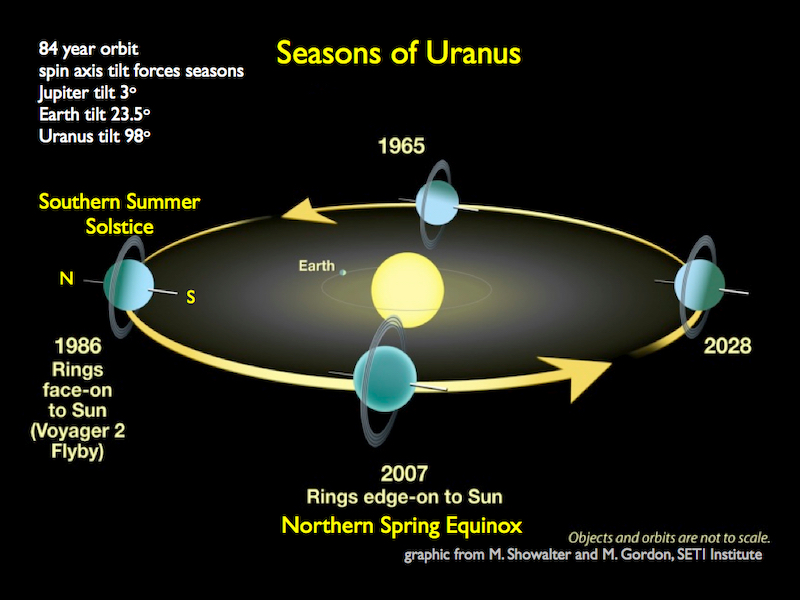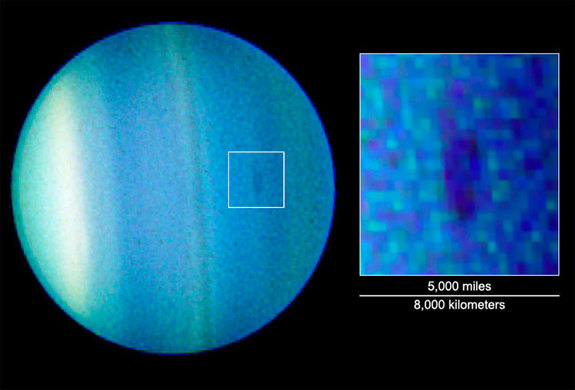Strange seasons of Uranus
Uranus has bizarre seasons, at least from our earthly perspective. As we explore distant exoplanets – or think about moons or rocky asteroids in this solar system – who knows what range of differences we’ll find? But for the moment we do know this. Uranus has unusual seasons, in contrast to Earth and the other major known planets. It’s because Uranus’ spin axis lies nearly sideways with respect to the plane of its orbit around the sun. Compared to Mercury, Venus, Earth, Mars, Jupiter, Saturn and Neptune – all of which spin elegantly, nearly upright, as they orbit our local star – Uranus seems almost as if it’s rolling around the sun, like a rolling ball.
Earth’s axis is tilted 23.5 degrees from perpendicular with respect to the plane of our orbit around the sun. Uranus’s axis is tilted at 98 degrees! So Uranus is tilted nearly sideways to the plane of the solar system, the single flat sheet of space in which nearly all the planets and moons orbit.
And, speaking of its orbit, Uranus orbits 1.8 billion miles (2.9 billion km) from the sun. Therefore, Uranus takes a long time to orbit the sun once. Its year is 84 Earth-years long. That makes each of its four seasons 21 years long. That’s another reason we on Earth think of Uranus’ seasons as strange.
Like Earth, Uranus has a nearly circular orbit, so it always remains at roughly the same distance from the sun. Unlike Mars – whose orbit is more elliptical than that of Earth or Uranus – Uranus’ distance from the sun isn’t a factor in its seasonal change.
Instead, as on Earth, the planet’s tilt is what gives Uranus its four seasons.
Extreme tilt means extreme seasons
So think about how Uranus’ tilt affects its seasons, in contrast to earthly seasons. Here’s one difference. Earth’s tilt means our north and south polar regions have a midnight sun in summer and a long polar night in winter. Since Earth’s axis tilt is relatively small, those dark and bright times at Earth’s poles affect a relatively small part of our planet.
But the tilt of Uranus’ spin axis – 98 degrees – is huge. As a result, in summer, one pole of Uranus plus a large section of that pole’s hemisphere faces the sun continuously for 21 years. Meanwhile, the other half of Uranus – the winter half – is in darkness for 21 years. That’s a long polar night, and a long midnight sun!
Bizarre spring and fall on Uranus
Spring and fall on Uranus are equally bizarre. Around the equinoxes on Uranus, sunlight strikes the equatorial region of the planet. During those seasons, the length of a day on Uranus plays an important role in its climate. Uranus spins on its axis about every 17 hours, 14 minutes. So its day-night cycle lasts that long.
So, for much of the planet’s spring and fall, a large percentage of the planet has day and night about every 17 hours. It’s quite a contrast to the summer and winter seasons when half the planet is either in darkness or daylight.


What we see from Earth and spacecraft
The extreme seasonal changes cause dramatic shifts in Uranus’ cloud patterns. Earth- and space-based observatories have observed this change over decades of Uranus-watching. The Voyager 2 spacecraft is the only craft from Earth that has ever flown past Uranus. That was in 1986. Voyager 2 encountered this world during its southern hemisphere summer. The spacecraft saw Uranus as blue and featureless.
In the years since Voyager 2’s flyby of Uranus, astronomical observing technologies have become more powerful. As Uranus moved in its 84-year orbit around the sun, we’ve seen the seasons on Uranus change.
Since the Voyager 2 observations, Uranus has emerged from the grip of its decades-long winter/summer season. Its southern hemisphere autumn equinox occurred in 2007; that’s when the sun was shining above Uranus’ equator. Sunlight reached some latitudes for the first time in years. Light and warmth in the atmosphere triggered gigantic storms comparable in size to North America (but with temperatures of -300 Fahrenheit/-184 Celsius), visible as bright spots in the planet’s atmosphere.
Following seasons of Uranus from Earth
Around that time, Earth- and space-based telescopes revealed more clouds in the atmosphere of Uranus. Bands encircling the planet changed in size and brightness as sunlight struck parts of the planet for the first time in decades. Plus, a dark spot appeared – and more bright spots – which observers were able to follow for years.
What more will we see in the decades and years ahead as Uranus moves toward the long winter/summer portion of its orbit once more?


Bottom line: The rotation axis of Uranus has a very large tilt that causes extreme seasonal changes. This results in increased activity in its atmosphere during the planet’s spring and fall seasons.
Read more: Uranus at opposition on November 16-17, 2024
Read more: Uranus discovered by accident in 1781